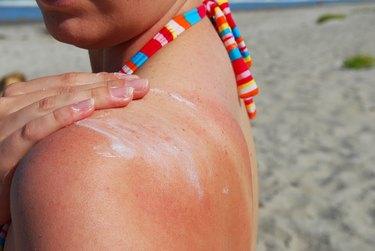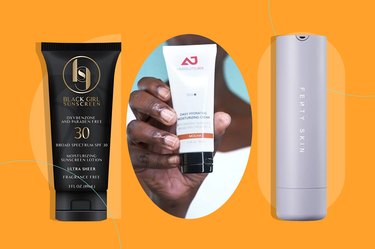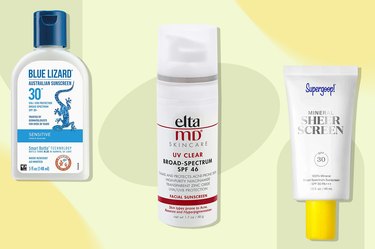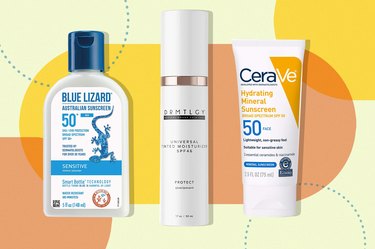
A nasty sunburn can all but erase those memories of a relaxing day on the beach or by the pool. When you're in the throes of dealing with the pain and tenderness, the only thing you can think about is when you might start to feel better.
Here, experts weigh in on when the healing will start to take place. Plus, what you can do to keep comfortable in the meantime.
Video of the Day
Video of the Day
Sunburn Severity
A sunburn is a reaction to skin damage caused by exposure to the sun's UV rays.
"When skin cells are injured from sun damage, our body triggers an inflammatory response to heal the injury," explains Hyemin Pomerantz, MD, a board-certified dermatologist with Viva Skin Dermatology and Aesthetics in Wellesley, Massachussetts. The result is skin that's red, swollen and painful.
Just how uncomfortable your sunburn is depends on its severity. Here's how the Cleveland Clinic breaks it down:
First-Degree Sunburns
- Redness
- Skin that feels hot or tight
- Tenderness or pain
- Blistering
- Swelling
- Peeling (several days later)
- In some cases, fatigue, headache, nausea or fever
Second-Degree Sunburns
- Extremely red skin
- Blistering and swelling over a larger area of skin
- Skin that looks wet or has white discoloration
- Pain
- In some cases, symptoms of heat illness, including confusion, exhaustion, dizziness, fever, headache, rapid breathing, muscle cramps, nausea or shivering
Third-Degree Sunburns (Rare)
- Leathery-looking skin
- Skin that's white or dull
- Numbness
- The above symptoms of heat illness, and potentially shock
How Long Sunburn Lasts
The amount of time your redness and discomfort sticks around depends on your sunburn's severity, with milder ones clearing up sooner than more severe ones.
First-degree sunburns will typically ease up within a few days to a week, though your skin might continue to flake or peel for a couple of weeks, Dr. Pomerantz notes.
Second-degree burns could be painful for several weeks and might need medical treatment, per the Cleveland Clinic.
Third-degree sunburns, which are very rare, cause severe skin damage and require long-term care.
How to Treat a Sunburn
Sunburned skin needs time to heal, so nothing can make a sunburn go away overnight. But there are ways to help the healing process along and keep yourself more comfortable in the meantime.
First and foremost? Stay indoors or in the shade while you're recuperating, Dr. Pomerantz recommends. More sun exposure will only make your already-tender skin more irritable and inflamed.
Per the American Academy of Dermatology, you can also try the following remedies for sunburns:
- Take cool baths or showers. The cool water will counter that hot, burning feeling. Towel off gently by patting your skin instead of rubbing it, which can cause irritation.
- Apply a moisturizer. Lotions with aloe or soy are especially soothing (which is why these ingredients are featured in many of the best after-sun lotions and products). If you're really uncomfortable, try using an over-the-counter hydrocortisone cream like Cortizone 10 ($7.76, Amazon), which can help your skin heal a little faster, Dr. Pomerantz says. For even more cooling power, place these in the fridge before using them.
- Drink more water. Drinking water doesn't help a sunburn, but you're more prone to dehydration when you've got a burn, so it's important to stay hydrated.
- Resist the urge to pop or pick. Blisters and peeling protect sunburned skin and help it heal. Plus, popping or picking could set the stage for an infection.
How to Prevent Sunburn
Even mild sunburns cause damage to your skin's cells that can lead to skin cancer. In fact, a person's risk of developing melanoma doubles with a history of five or more sunburns, according to the Skin Cancer Foundation.
The best way to protect your skin: "Stay out of the sun and practice vigilant sun protection," Dr. Pomerantz recommends. That starts with wearing a sunscreen every day with SPF 30 or higher. "The higher the SPF, the longer it takes for skin to turn red when it's exposed to UV light," she explains.
Also, be diligent about reapplication. Most sunscreens recommend reapplying every two hours, but this should be even more frequent if you're sweating or in the water.
In addition to wearing sunscreen, try to stay out of direct sunlight between 10 a.m. and 4 p.m., when the sun's rays are strongest. Also, consider wearing a wide-brimmed hat and sun-protective clothing, recommends the Cleveland Clinic.
Be mindful, too, of any medications you take that could make your skin more sensitive to the sun (like retinoids and some antibiotics and statins), Dr. Pomerantz says.
When to See a Doctor for Sunburn
You can usually care for a sunburn at home. Let your doctor know if your sunburn causes large blisters on your face, hands or genitals, or if the sunburn becomes increasingly painful or causes a headache, nausea, fever, chills, eye pain or vision changes, the Mayo Clinic recommends.
You should also seek emergency medical attention for sunburns accompanied by a fever over 103 degrees Fahrenheit and vomiting, confusion, infection or dehydration.
FAQ
Here are a few more things to know about sunburns:
1. Do Sunburns Turn Into a Tan?
Some people tan without getting sunburned, and for other people, sunburns will eventually fade into a tan, Dr. Pomerantz says. Which camp you fall into depends on how much melanin (the pigment that gives skin its color) is in your skin. Melanin is the body's safeguard against sun damage, and the more a person has, the less prone they may be to burning.
That's not to say that having dark or tan skin means you don't have to worry about skin cancer. Both tans and sunburns are signs that your skin has sustained sun damage, according to an August 2015 paper in JAMA. And people of all skin colors, including those with brown or black skin, can still get skin cancer.
2. What Day of a Sunburn Is the Worst?
The discomfort will likely peak between 12 and 24 hours after you were exposed to the sun, Dr. Pomerantz says. By then, the inflammatory mechanisms like redness, swelling and tenderness will have had enough time to fully kick in.
3. Can a Sunburn Go Away in 2 Days?
It's possible, if you're dealing with a mild sunburn. If your skin is extremely red, swollen and painful, though, it may take a week or more to heal.
4. What Should You Not Put on a Sunburn?
Cool compresses and soy- or aloe-containing lotions are soothing options, but there are some topicals you'll want to steer clear of.
Products containing alcohol or anesthetics like benzocaine are at the top of the list. The former can further dry out your skin; the latter can irritate it and in some cases trigger a serious allergic reaction, the Mayo Clinic notes.
Also avoid using petroleum- or oil-based ointments, too, recommends the Skin Cancer Foundation. These products can actually trap heat that's being emitted from your skin and worsen your burn. Similarly, you should avoid antibiotic creams or ointments unless your provider has recommended them.
Is this an emergency? If you are experiencing serious medical symptoms, please see the National Library of Medicine’s list of signs you need emergency medical attention or call 911.


